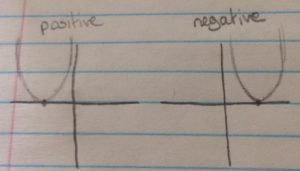April 2018 archive
This week we learned how to graph inequalities with two variables. These inequalities are essentially forms of the equation y=mx+b, used to graph lines. The same idea can be applied to graphing the inequalities.
However depending on the inequality the line will either be broken or solid.
solid line =  or
or 
broken line =  or
or 
using the same idea as y=mx+b, we can find the slope, and the y-intercept.
“m” represents our slope, if it’s a whole number it can be read as  with “n” being your rise(y), and 1 being your run(x).
with “n” being your rise(y), and 1 being your run(x).
For instance: If you were to graph  , your y-intercept would be 2, and your slope would be
, your y-intercept would be 2, and your slope would be 
It would look like this:

The area shaded, is figured out by testing x and y coordinates in your equation, until the equation is made true through the coordinates chosen.

When faced with a problem where you have to solve for “x” but aren’t able to get rid of the  by squaring both sides right away, you first have to isolate both “x” variables on one side of the equation.
by squaring both sides right away, you first have to isolate both “x” variables on one side of the equation.
Now we can get rid of the square root by squaring both sides.


On the right side of the equation,  turns into
turns into  because we have to expand. You aren’t able to just do the math.
because we have to expand. You aren’t able to just do the math.
Now, since our equation is quadratic we can make our equation equal to zero, and factor it to find our roots.

Lucky for us this equation factors nicely:
$latex 0=(x-12)(x-3)
So, x=12 and/or x=3
To check we plug one of our newly found “x’s” into our equation. If one doesn’t work, there’s still a chance that the other one will. ALWAYS check both!





This one DOES NOT work!!! However, we’ll check x=12 to check if that one does work.





So x=12 is a root, but x=3 is not. Therefore, the equation only has one root.
This week we learned about graphing quadratic equations in factored form. In factored form, we can find the roots, as well as the axis of symmetry. With this information, we can draw a quick graph depicting what our parabola would look like.
ex. Graph the equation 
graphing the equation with only the factored form won’t give us a complete parabola, but it will give us enough information to get a rough idea.

$latex y=-2(x+5)(x-2)
replace the “y” with 0.
0=-2(x+5)(x-2)
rearranging the bracketed “x’s” will give us our roots
(x+5) -> x=-5, (x-2) -> x=2
with the x-intercepts, we know that when graphed will be in the format (x,y). But since the x-intercept is where the parabola crosses the x-axis, the y-intercept will equal 0. The x-intercepts will be (-5,0) and (2,0). The axis of symmetry is half way between both roots, so the AOS will be x=-1.5.
https://www.nytimes.com/2018/03/24/us/politics/students-lead-huge-rallies-for-gun-control-across-the-us.html
This articles acknowledges the plea’s and cries of America’s youth on Gun Control. There is no excuse for the murders of thousands of students that have taken place over the years. America’s young people will no longer stand by and watch as nothing is done to insure their safety, and instead take initiative in ensuring their future. This article describes the events that took place during the March For Our Lives rallies that took place on March 24, 2018, in over 390 of the country’s 435 congressional districts. The author used descriptive language to acknowledge the major movements that occurred that day, including the many speakers and performers.
This week we learned about parabolas and how they can be translated on a graph.
A translation is an image of the original parabola, but moved either horizontally or vertically from the original parent equation 

Depending on the equation, you can determine where the parabola has moved on the number line.
If the coefficient of  changes, the parabola will either stretch or compress. A coefficient less than 1 will cause the parabola to compress, while a coefficient more than 1 will cause it to stretch.
changes, the parabola will either stretch or compress. A coefficient less than 1 will cause the parabola to compress, while a coefficient more than 1 will cause it to stretch.

If the coefficient  is negative the parabola will open down, while if it’s positive it will open up.
is negative the parabola will open down, while if it’s positive it will open up.

In the case that your equation looks similar to  , with your numbers in brackets, then the “c” will effect whether your parabola translates left or right. If the number is positive, it will translate left, and if it’s negative it will translate right. It does not follow the general idea that negatives go left and positives go right.
, with your numbers in brackets, then the “c” will effect whether your parabola translates left or right. If the number is positive, it will translate left, and if it’s negative it will translate right. It does not follow the general idea that negatives go left and positives go right.

or
or
with “n” being your rise(y), and 1 being your run(x).
, your y-intercept would be 2, and your slope would be




